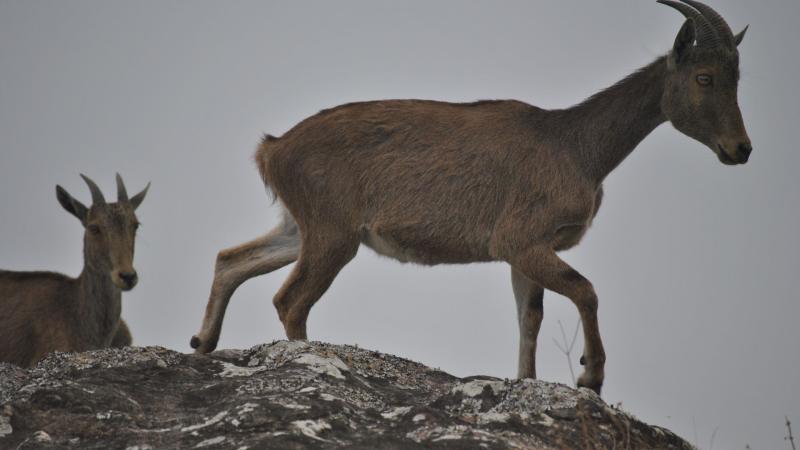
Climate change and global warming are poised to impact every aspect of our planet—the food that we grow, the air that we breathe, the forests and even the remote ice caps in the poles. Studies all over the world have pointed out that the changing climate is disastrous not only for humans, who are mainly responsible for it but also for the billions of other life forms—both on land and in water. One such collaborative study that included researchers from the Ashoka Trust for Research in Ecology and the Environment (ATREE), has analysed how climate change could affect the habitats of the Nilgiri Tahr in the years to come.
The Nilgiri Tahr (Nilgiritragus hylocrius) is an endangered, hoofed mammal (ungulate) endemic to the Western Ghats. Once found in plenty in the montane grasslands and the Shola forests, they are now reduced to a meagre 3000 due to rampant hunting and loss of habitat. In fact, over the years, their habitat has been reduced to just one-tenth of their original range.
The current study, published in the journal Ecological Engineering, is the first to look at the effect of climate change on these elegant mammals. It predicts that most of the existing habitats of the Nilgiri Tahr in the Western Ghats will become unsuitable as global warming intensifies.
Why did the researchers choose to study the Nilgiri tahrs?
“Even though tahr populations in the Eravikulam National Park is well monitored and managed, the small populations (of size ranges between 8-30) in different parts in the southern Western Ghats did not receive attention. We realised that it is important to look at these small populations and the effects of climate change since they are more vulnerable to local extinction”, says R K Sony from ATREE who is also an author of the study.
The researchers conducted their study in ten Tahr habitats including the Periyar Tiger Reserve, Neyyar wildlife sanctuary and Silent Valley National Park, during 2010-2011. For the first time, the study used the ecological niche model—an ecological model that uses the relationship between a species and its habitat to identify potential species distribution. They predicted the species distribution of the Tahr in varying climate scenarios over the course of three timeframes—the 2030s (2021–2050), 2050s (2040–2069) and 2080s (2070–2099).
The future climate projections in the study were based on two scenarios. The first scenario represented an optimistic emission rate, with the peaking of emissions by 2040, while the second scenario represented a continuous rise in emissions all through the 21st century.
The results of the study showed a drastic loss of habitat in all future time scenarios. It predicted a maximum habitat loss of 61.2%, 61.4% and 63% for 2030, 2050 and 2080 respectively if the current rate of emissions did not reduce.

The projected loss in the habitat of the Nilgiri Tahr
The researchers identify the rising temperature to be the main culprit causing the havoc.
“The loss of habitats is mostly driven by temperature variables. Even though the models suggests the importance of precipitation variables, but there are uncertainties associated with them; especially, the future rainfall projections may not be always accurate. A majority of the current climatically-suitable habitats of the Nilgiri Tahr are predicted to become unsuitable when global warming intensifies”, explains Sandeep Sen, a co-author of the study, also from ATREE.
The reduction in the habitats is of grave concern in conserving these mammals from the brink of extinction.
"In the absence of the data on the movements of these animals between the high-altitude forest grasslands separated by thick forest barriers, the possible impacts on the habitat suitability are increasing the chances of local extinction," says Dr. Jayahari KM, an author of the study.
Are we too late to then save these large mammals from the impending habitat loss? Not yet, say the authors, who point out that conservation and management of suitable habitats outside the existing ones will be helpful to curb the effect of climate change on the Tahr as well as its associated species.
The study unearths the possibilities of severe threat to the natural habitats of these species, which demands a comprehensive species management plan. The authors stress the need for detailed, habitat-based ecological observations and genetic studies to develop such management strategies.






